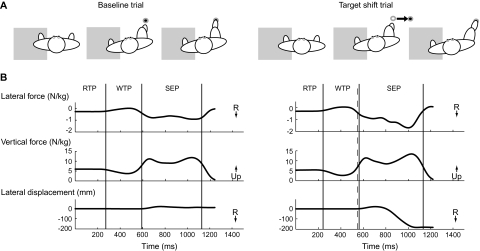Figure 1.
(A) Overhead view of the experimental setup for baseline and target shift trials. The supporting leg was on a force plate (gray rectangle). After an auditory “ready” cue, the appearance of the visual target acted as the “go” cue. In baseline trials, the target (filled circle) was positioned directly in front of the stepping foot. In target shift trials, the target unpredictably and instantaneously shifted from its initial location to a new location 20 cm to the right. (B) Lateral and vertical ground reaction forces under the supporting foot and movement trajectories of the stepping foot in the medial/lateral direction from a typical young control participant during a baseline (left) and target shift (right) trial. Vertical lines delineate the boundaries of the response time (RTP), weight transfer (WTP), and step execution (SEP) phases. Response time phase = time from initial target illumination to onset of the first decrease in the vertical force under the supporting leg to below 5% of the mean vertical force during quiet standing. Weight transfer phase = time from the end of response time phase to onset of heel-off on the stepping leg. The weight transfer time encompasses the very well characterized and stereotyped lateral weight shift, first toward the stepping side, then the supporting side, that rapidly unloads the stepping leg before step initiation (20–22). Stepping execution phase = time from the end of weight transfer phase to subsequent initial contact of the stepping leg onto the target. Dashed vertical line indicates the time of the target shift (in this case, 550 ms after initial target illumination).

